Video of the Week:
Growing Vegetables in Containers
Vegetables:
Setting Out Tomatoes Early
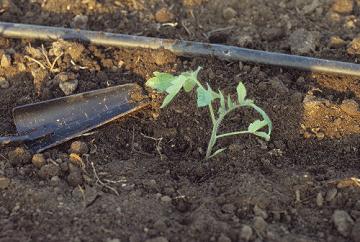
Adequate soil temperature: Tomato roots do not do well until soil temperatures reach a fairly consistent 55 degrees F. Use a soil thermometer to check the temperature at 2 inches deep during the late morning to get a good average temperature for the day. Most soil temperatures in Kansas now are in the 40's. Plastic mulch can be used to warm soil more quickly than bare ground. Purple leaves are a sign of phosphorus deficiency due to cool soils.
Harden off plants: Plants moved directly from a warm, moist greenhouse to the more exposed and cooler conditions outside may undergo transplant shock. Transplant shock causes plants to stop growing for a time. Plants can be acclimated to outside conditions by placing them outdoors in a location protected from wind and full sunlight for a few days before transplanting.
Another way to harden off plants is to transplant them and place a cardboard tent or wooden shingle to protect them from wind and sun for 2 to 3 days. The best conditions for transplanting is an overcast, still day.
Protection from frost: Tomatoes cannot tolerate frost. Though we are past the average date of the last frost in most of Kansas, watch the weather and cover the plants if frost threatens. A floating row cover or light sheets can be used for protection. Actually a floating row cover can be left on the plants for two to three weeks to increase the rate of growth and establishment.
Other tips for getting tomato plants off to a fast start include:
1. Use small, stocky, dark green plants rather than tall, spindly ones. Smaller plants form roots rapidly and become established more quickly than those that are overgrown.
2. Though tomatoes can be planted slightly deeper than the cell-pack, do not bury the plant deeply or lay the stem sideways unless the plant is very leggy. Though roots will form on the stems of tomatoes, this requires energy that would be better used for establishment and growth.
3. Use a transplant solution (starter solution) when transplanting to make sure roots are moist and nutrients are readily available.
4. Do not mulch until the plant is growing well. Mulching too early prevents soil from warming up. (Ward Upham)
Help for New Vegetable Gardeners
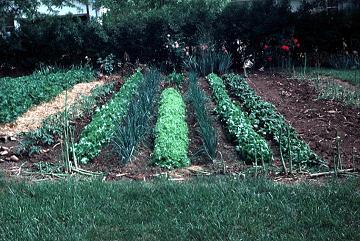
Another, more in-depth publication titled the “Kansas Garden Guide” is also available. This 77-page booklet has sections on planning a garden, composting, improving soil, seeding and planting, garden care, watering, planting gardens for fall production, insect and disease control, container gardening, season extension and harvesting and storing. This is followed by an extensive section on how to grow specific vegetables and herbs. You may order the print publication at http://www.ksre.ksu.edu/bookstore/Item.aspx?catId=534&pubId=8219 This web page also provides a link to a free PDF copy of the same publication.
If you don’t know the location of your county extension office, see http://www.ksre.ksu.edu/Map.aspx (Ward Upham)
Fruit:
Fertilizing Strawberries and Brambles
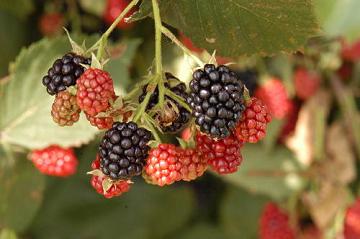
Strawberries (June-Bearing): June-bearing strawberries are not fertilized in early spring as this can make the berries soft and more prone to rot. Fertilize at renovation and again in late August to early September. In most cases, strawberries need primarily nitrogen, so the recommendations are for a high nitrogen fertilizer such as a 27-3-3, 29-5-4, 30-3-3 or something similar. Though recommended for lawns, these fertilizers will also work well for strawberries as long as they do not contain weed killers or crabgrass preventers. Apply ½ cup for every 10 feet of row. Note: For more information on renovating strawberries, see http://www.hfrr.ksu.edu/doc3732.ashx
Strawberries (Everbearing or Day-Neutral): Fertilize in the spring as growth starts and again in early August. Use the rates recommended for June-bearing strawberries. Everbearing (dayneutral) strawberries are not renovated.
Brambles (Blackberries and Raspberries): In most cases, brambles need primarily nitrogen, so use a high nitrogen fertilizer such as a 27-3-3, 29-5-4, 30-3-3 or something similar unless a soil test directs otherwise. Though recommended for lawns, these fertilizers will also work well as long as they do not contain weed killers or crabgrass preventers. Apply ½ cup for every 10 feet of row. Fertilize in spring as growth begins. (Ward Upham)
Fertilizing Blueberries
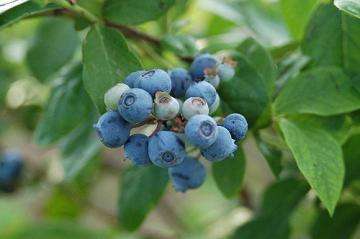
Year of Planting: Apply fertilizer according to soil test and work into the soil before planting. Every six weeks thereafter apply a high nitrogen fertilizer such as a 27-3-3, 29-5-4, 30-3-3 or something similar. Though recommended for lawns, these fertilizers will also work well for blueberries as long as they do not contain weed killers or crabgrass preventers. Apply 1 teaspoon per plant within a circle within 12 inches of the plant. Do not apply fertilizer past August 15. Urea (46-0-0) may be substituted for the fertilizer recommended above but cut the amount to a rounded ½ teaspoon per plant.
Second Year: Double the rates recommended above and increase the area treated to within 18 inches of the plant. Apply the first application when the new growth appears in the spring and continue every six weeks but not after August 15.
Third Year and Following: - Apply 1/3 cup of the fertilizer recommended above within three feet of each plant when growth begins in the spring. Bushes should produce 6 to 12 inches of new growth each year. If less than this is produced or if you wish larger plants, apply 1/4 cup of fertilizer every 6 weeks. Do not apply fertilizer after August 15. (Ward Upham)
Eliminating Unwanted Fruit from Trees
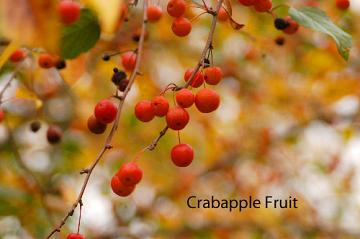
Florel is sold in many stores as a fruit eliminator. The active ingredient is ethephon, a chemical that releases ethylene, which causes fruit to drop before it sets. According to the label, a foliar application of Florel will reduce or eliminate undesirable fruit development on many ornamental trees and shrubs such as apple, cottonwood, crabapple, elm, flowering pear, horse chestnut, maple, oak, pine, sweetgum, and sycamore. But how well it works and potential damaging effects depend on the dose and temperature. Activity slows if the temperature is below 60 or above 90 degrees F. Because Florel degrades quickly in water, applications should be completed within four hours of mixing. Timing of the application must coincide with full bloom, a stage that requires close observation with many of our trees.
Researchers at K-State's John C. Pair Research Center near Wichita have gotten mixed results using Florel on treated crabapples. With some varieties, fruit was substantially thinned. Others showed no effect. We cannot make firm recommendations on the use of this product without research results on other tree species. (Ward Upham)
Pests:
Skip the Detergent
Article provided by: Insight Pest Solutions that Raymond Cloyd contributed to and can be found at: http://www.insightpest.com/pest-control (Raymond Cloyd)
Miscellaneous:
Poison Ivy Identification and Control
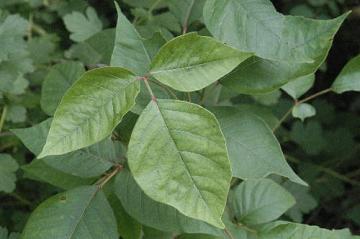
There are three methods commonly used to eradicate poison ivy. These include pulling or grubbing out the plants by hand, cutting off the vine, and then treating the regrowth, and spraying the plants directly. The method used depends somewhat on the plant's growth form. If the plant is growing as a groundcover, direct spray or grubbing the plant out is often used. If grubbing, wear gloves and a long-sleeved shirt. The soil must be moist for grubbing to work well. Wash the clothes and yourself immediately after you finish. It might also be a good idea to rinse the washing machine. If the plant is in the shrub form, direct spray is the most common control method. If the plant is a woody vine that has climbed a tree, the preferred method is to cut the plant off at the base and treat the sprouts after they emerge. Some triclopyr herbicides also have instructions on treating a freshly cut stump directly. Triclopyr (Brush-B-Gon Poison Ivy Killer, Brush Killer Stump Killer) is most often used for poison ivy control. Other herbicides that can be used include glyphosate (Roundup, Killzall Weed and Grass Killer, Nutgrass, Poison Ivy and VineKiller) or dicamba. Poison ivy is tough. Repeat applications may be necessary. (Ward Upham)
Contributors: Raymond Cloyd, Entomologist; Ward Upham, Extension Associate
 RSS Feed
RSS Feed
